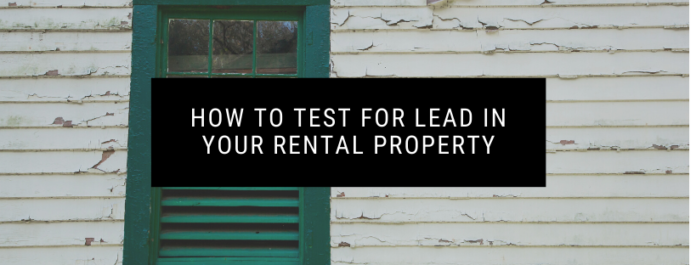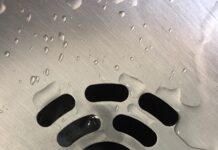Are you worried that your property might have a lead problem? Was your child recently tested with results that showed exposure to lead?
Are you pregnant and want to make sure there’s no lead on your walls?
Whatever your reason may be for wondering how to test for lead, there are DIY ways to do it!
Swallowing or breathing lead is what causes lead poisoning. And kids under 6 years of age are most at risk because they put their hands in their mouths much more often than older children and adults.
It’s a misconception that you can tell if the paint has lead just by looking at it. So if you’re worried at all, don’t hesitate to test your property.
Keep reading to learn all about lead and how to test for it.
When Was Lead Paint Used?
The federal government banned consumer uses of paint that contained lead in 1978. Some states banned it early, but by 1978 it was banned across the United States.
Even though lead paint isn’t used in newer homes, there are plenty of older properties across the country. Many homes contain lead paint underneath the many layers of newer paint.
If the paint is chipping, chalking, cracking, peeling, damp, or damaged in any way, it’s considered hazardous.
Some surfaces where lead paint is typically found are:
- Doors and door frames
- Railings, stairs, porches, and banisters
- Window sills and windows
Keeping your home in excellent shape and dusting frequently will help prevent contamination in the meantime if your home does have lead.
In addition to deteriorating paint, lead dust is also tracked in from contaminated soil. If that soil contains exterior lead-based paint, industrial pollution, or remnants of leaded gasoline, it can still contaminate members of your home.
Renovations and repairs are one of the easiest ways to expose humans and living creatures to lead paint as it’s most dangerous when those surfaces are demolished or disturbed in any way.
Lead has previously been used in pipes, water service lines, and other plumbing materials. It can leach into the water as that same water flows through the plumbing.
The same source tells us that lead was used in plumbing and pipes up until 1986. So if it’s not in your paint, it may be in your drinking water.
What Products Contain Lead?
Painted toys, jewelry, and furniture, especially from the past, can easily contain lead.
If a child chews on toys that have lead, or even handles them and then puts their fingers in their mouth, they will probably suffer from some degree of lead poisoning.
Remember all those fake jewelry toys that were found in vending machines? Most of those contained lead, and in 2004, 150 million pieces of that jewelry was recalled.
Crayons, chalk, children’s clothing, and other children’s products have all been recalled over the years for containing lead paint.
The same source shows us that it wasn’t until 2014 that additional changes to the Safe Water Act reduced even further the allowable amount of lead in pipes.
Even “lead-free” homes and pipes can contain small percentages of lead.
Dust, soil, and some food or liquid containers can also leach lead. Lead crystal or lead-based porcelain or pottery pieces that are meant for food or liquid storage can also leach lead into those products.
What Are the Health Effects of Lead Exposure?
Lead is extremely toxic. It’s especially hazardous to unborn babies and small children but is also detrimental in high quantities to adults.
In young children, abnormally high levels of lead can cause a number of ailments, such as:
- Kidney damage
- Behavioral and learning problems
- Damage to the brain and nervous system
- Slowed growth
- Hearing problems
- Nerve damage
- Headaches
- Bone marrow problems
Children who experience these health problems from lead won’t necessarily show symptoms, which is why it’s so important for young kids to be tested.
In adults, exposure can lead to a number of health issues as well, such as:
- Fertility problems
- Hearing or vision loss
- Anemia
- Kidney damage
- High blood pressure
- Nerve disorders
- Muscle and joint pain
- Memory and concentration problems
Many of the health issues caused by lead exposure are not reversible, which is why it’s vital to get to the bottom of where potential lead sources are.
Why Would Someone Test Their Home for Lead?
There are many reasons to test your home for lead.
If your home was built before 1978, you should test for lead. And if your home is near a busy roadway or freeway where exhaust or gasoline may have polluted the soil with lead, you should also test for lead.
If you have small children in your home, the property was built before 1978, and you have bare soil in your yard or peeling paint, it’s a good idea to test your home. If your child was recently tested and showed higher levels of lead, or if you’re planning on doing renovations, you should also test for lead.
How Do You Test Your Home for Lead?
For $50 or less, you can take a sample of soil or a paint chip and have it tested by an accredited laboratory. Typically, results don’t take more than 24-48 hours.
If you take a sample of paint, make sure that you get through the underneath layers, as that is probably where the lead is. Use a chisel or a blade to scrape off a piece and put it in a plastic sandwich bag.
If you want to take a sample of soil, scoop about a half cup from the top inch of the soil that’s around your home. Try not to include any sticks, leaves, or large debris. If there is any paint in the soil, however, that’s ok.
Put your soil sample in a plastic sandwich bag as well.
Instead of sending out samples you acquire yourself, you can also hire an inspector to test your home for you. Do your research and hire a reputable company with reviews and experience.
They’ll send samples out to be tested in addition to using an XRF machine for immediate results.
Make sure you get a quote of how much services will be, what testing it includes, and where they send their samples. You want to make sure every inch of your house is scoured, especially if you have a child that tested positive for higher levels and you’re not sure where it came from.
If you’re renting and your child tested positive for lead, your landlord should bear the financial responsibility for testing your home.
How to Do a DIY Test
The EPA recommends hiring a professional to test for you, especially if there are young children who have tested for higher than normal levels.
But there’s nothing wrong with doing it yourself, especially as an initial, much cheaper, test.
You can buy a kit that’ll test ceramics or paint for $10 or less. While they’ll tell you if there’s lead in the paint you’re testing, they won’t tell you how much is there.
You can’t use these tests to test for soil either.
The Klean-Strip kit is EPA certified and is set up for 6 samples. However, it does have an expiration date, so be sure to check if you use this test. While this test is a little more expensive, it’s certified to check both wood and drywall materials.
Again, it will indicate whether or not there’s a presence of lead, but it won’t tell you how much.
If you want to test more than just paint or drywall, you can send your own paint, soil, and other samples to a lab.
Be sure to check with them beforehand to make sure you package and send the samples correctly. This will be a little more expensive than using a kit, but the lab test will give you specific levels, and you can send your soil here as well.
What If the Tests Show Lead?
If your property’s paint or soil shows levels that are hazardous, contact your children’s doctor and have their blood tested for lead.
If you performed the test yourself, consider hiring an EPA-certified professional to test and determine every place in your home where there’s lead.
Hire a contractor to reduce the lead in your home and take the proper safety precautions for cleaning and decreasing the amount of dust.
If you ever plan to remodel your home, make sure you hire a state-certified lead contractor.
If you’re renting and you want to break your lease because you discover the property contains lead, here are some tips for getting out of a lease.
Knowing How to Test for Lead Doesn’t Cost Much If You Do It Yourself
If you’re worried that your property has lead, but you aren’t ready to fork out cash to have a professional test for you, take the first step and do it yourself.
How to test for lead isn’t hard, and you can test your paint for under $10.
Lead is toxic and especially harmful for young children. Many of the damage caused by lead poisoning is irreversible.
If you think about it that way, it’s worth the cost to have your home thoroughly tested so that you can move forward with peace of mind knowing that you’re children are safe, or that you’re going to take the necessary precautions to keep them safe.




















